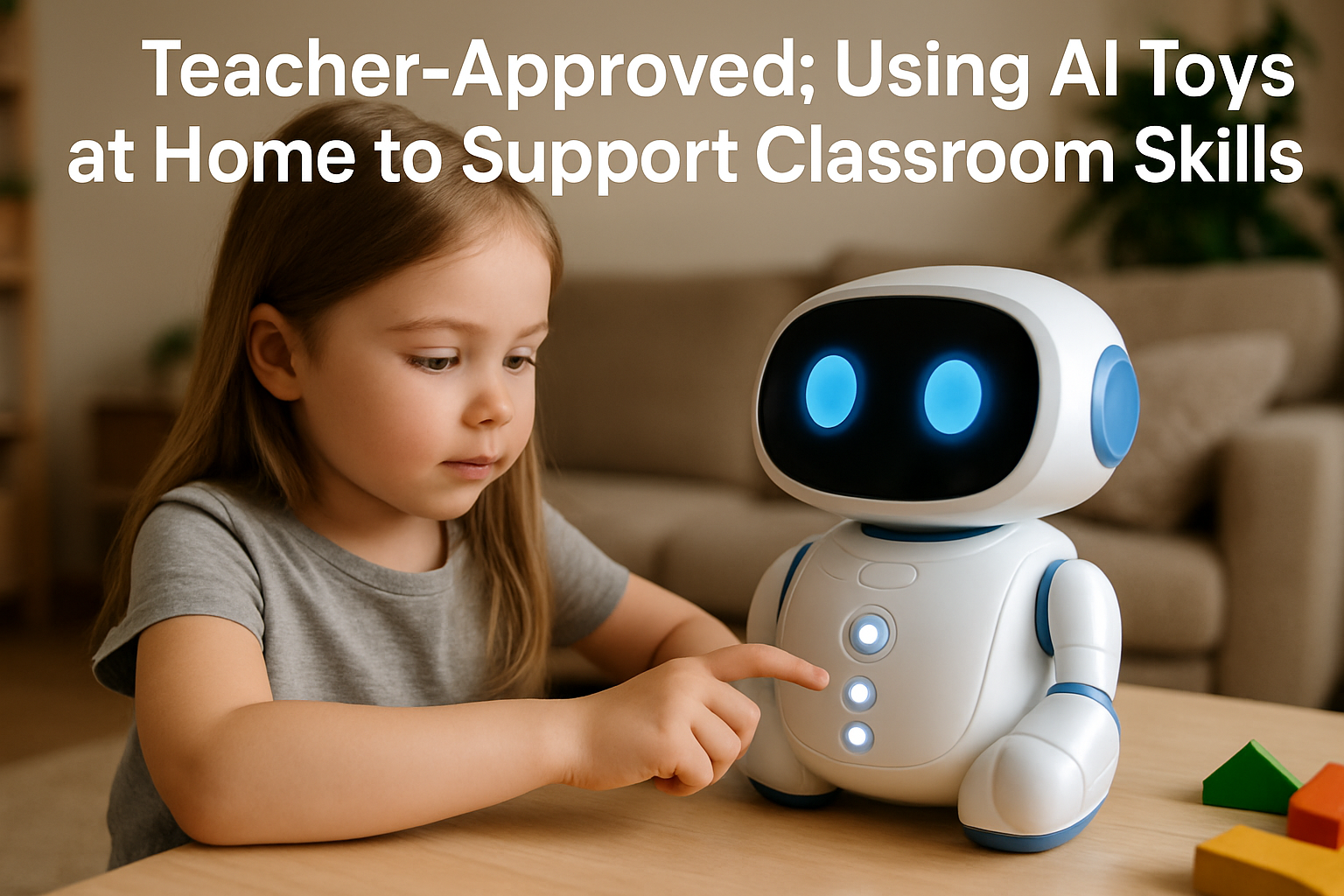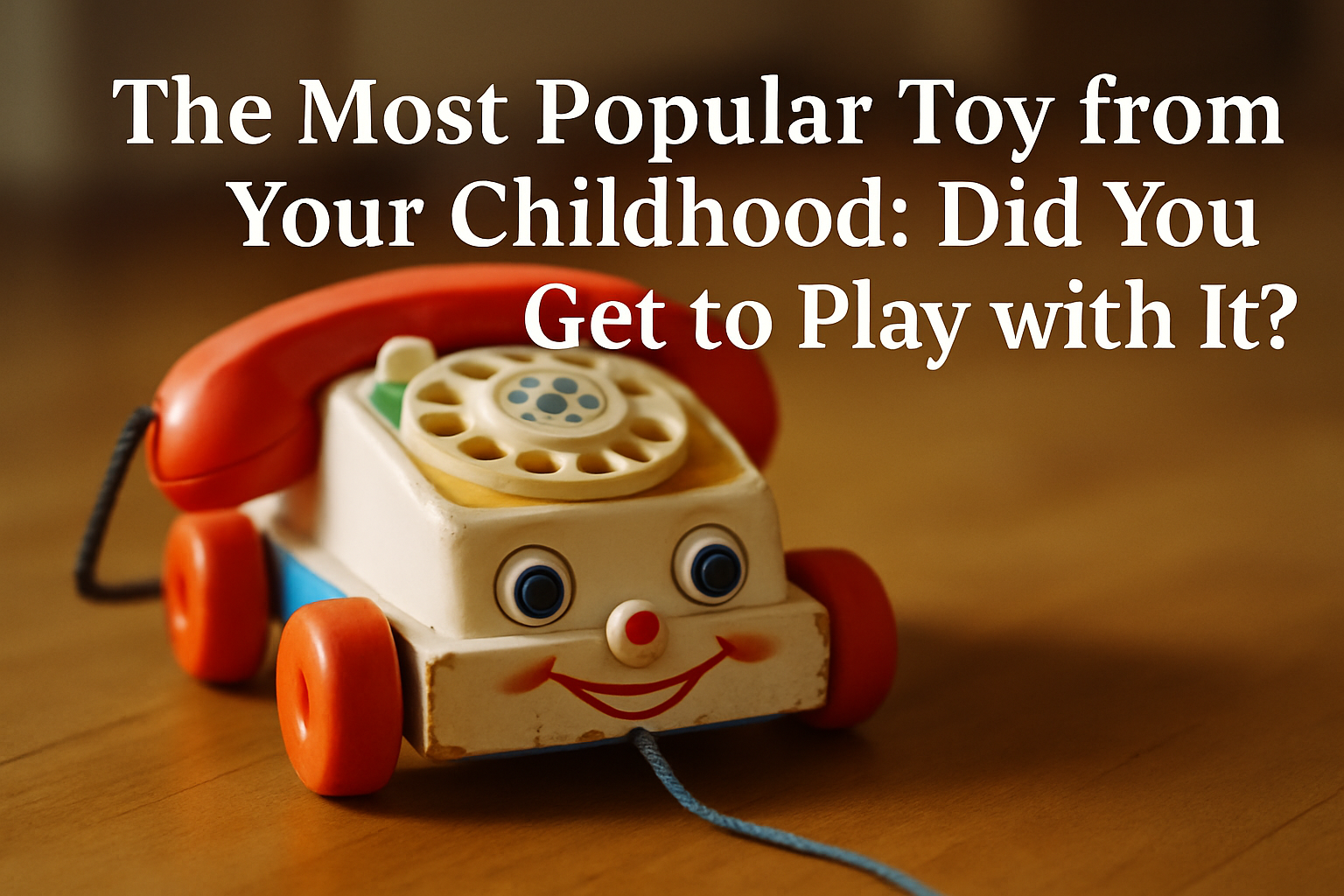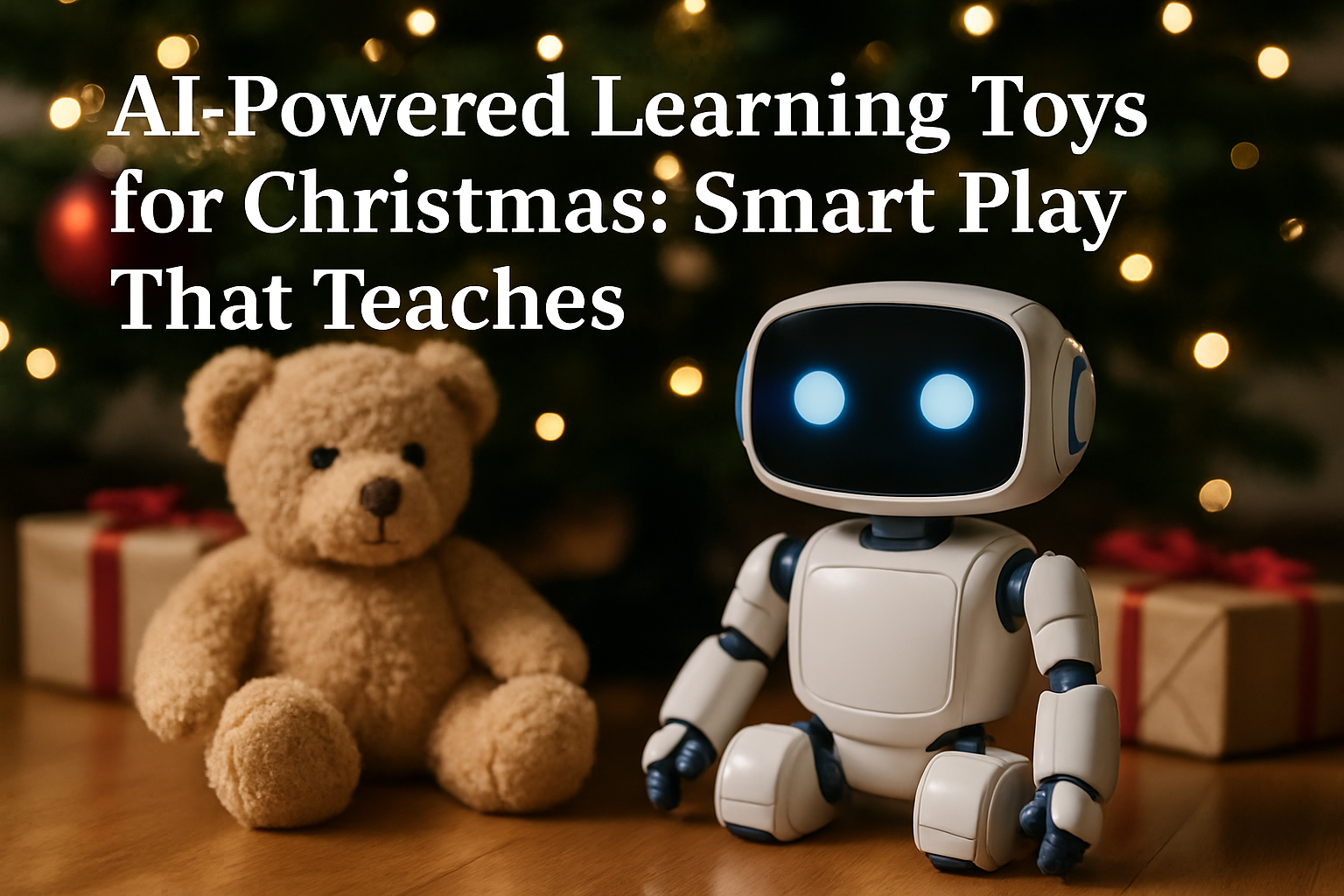The Most Popular Toy from Your Childhood: Did You Get to Play with It?
IntroductionThe popularity of AI toys in education is on the rise, sparking i...
Add description, images, menus and links to your mega menu
A column with no settings can be used as a spacer
Link to your collections, sales and even external links
Add up to five columns
Add description, images, menus and links to your mega menu
A column with no settings can be used as a spacer
Link to your collections, sales and even external links
Add up to five columns

The popularity of AI toys in education is on the rise, sparking interest among parents, educators, and children alike. These innovative toys merge technology with play, creating dynamic learning experiences that engage young minds. As education evolves, these tools are becoming more integrated into homes and classrooms, reflecting a shift towards interactive and personalized learning methods that can be tailored to individual needs.
At the heart of the appeal of AI toys is the intersection of play and learning. Play is a fundamental aspect of childhood development, serving as both a natural way for children to explore their environment and a critical method for acquiring essential skills. By placing AI toys into this context, we see how they can transform typical play into a structured educational experience. They foster curiosity and creativity while also promoting vital cognitive skills. As children engage with these toys, they are not just having fun; they are developing problem-solving abilities, critical thinking, and emotional intelligence in an enjoyable setting.
AI toys encompass a wide array of interactive devices designed to stimulate learning through play. Defined, AI toys integrate artificial intelligence technology to respond to children's actions, providing customized feedback and adapting to their learning pace. These features can include interactive storytelling, responsive conversation, and educational games that evolve based on a child’s progress. Popular examples range from robotic toys that teach coding fundamentals to plush characters that facilitate emotional learning. These AI toys are making significant contributions to both home and classroom environments, as they bridge the gap between education and entertainment.
The purpose of this report is twofold: first, to explore how AI toys can impact classroom skills and second, to highlight the level of approval these toys receive from teachers for use at home. Recent studies indicate that classroom engagement is enhanced with AI toys, inspiring interest in subjects like mathematics and science through gamified experiences. Furthermore, teachers are recognizing the value of these tools in reinforcing skills learned during formal tutoring sessions. By showcasing the evidence of teacher approval for utilizing AI toys outside of school, this report aims to provide parents and educators with insights into the potential benefits of integrating AI toys into children's daily routines.
The integration of AI toys into the learning environment offers significant advantages for children's development. These toys play a substantial role in enhancing cognitive skills, improving social skills, and supporting emotional growth. As children engage with these technological innovations, their learning experiences become more enriched and interactive, leading to beneficial outcomes across various developmental areas.
AI toys stimulate cognitive development primarily by enhancing critical thinking and problem-solving skills. These toys often present challenges that require children to think analytically. For instance, they might need to devise solutions to puzzles or navigate through interactive scenarios that demand a strategic approach. This process requires active engagement, which correlates with improved cognitive functions such as reasoning and logic. Through repeated interactions with AI toys, children can build a robust foundation in these essential skills, which will serve them well in both academics and everyday life.
Additionally, AI toys significantly support STEM education. This emphasis is vital for fostering an early interest in science, technology, engineering, and mathematics, fields that are pivotal in today's job market. Through playful exploration and experimentation with AI-powered tools, children can gain hands-on experience in these areas. The engaging nature of these toys makes learning about complex subjects more accessible and enjoyable, encouraging a robust understanding of STEM concepts from a young age.
Moreover, the adaptive nature of AI toys allows them to tailor challenges to meet individual learning needs. This personalized approach ensures that children are neither overwhelmed nor bored, striking a balance that fosters sustained engagement. As they progress, the toys adjust their difficulty levels, thus continuously challenging young minds while reinforcing their understanding. Over time, this tailored learning experience can propel children's cognitive capabilities, setting them up for academic success.
AI toys also play a pivotal role in improving children's social skills. They often promote collaboration and teamwork, allowing children to work together towards common goals. Many AI toys encourage cooperative play, where children must communicate and share ideas to solve problems. This interaction fosters a sense of community and belonging, essential components in social development.
In addition to facilitating teamwork, AI toys encourage communication skills through interactive play. Many of these devices require verbal interaction, prompting children to articulate their thoughts and commands clearly. As children engage with AI toys, they practice and enhance their vocabulary, learn to express their ideas, and develop the ability to listen and respond to peers. This dynamic interaction ultimately supports the development of effective communication skills that are critical in everyday social interactions.
Furthermore, the scenarios provided by AI toys often simulate real-life situations, giving children opportunities to negotiate, reach compromises, and understand various social cues. Such experiences are invaluable for nurturing empathy and emotional intelligence. By navigating through these interactions, children learn to relate to others' feelings, understand diverse perspectives, and cultivate friendships. These social skills will greatly benefit them as they progress through school and into adulthood.
The emotional and behavioral growth of children is another essential benefit of AI toys. These toys often foster creativity and self-expression by allowing children to explore stories and scenarios in imaginative ways. They can adapt their narratives based on children's choices, encouraging them to think outside the box and embrace their creative instincts. This playful interaction not only stimulates imagination but also allows children to express themselves freely, contributing positively to their emotional well-being.
Moreover, AI toys aid children in managing their emotions and building resilience. Many toys are programmed to recognize emotional responses, providing feedback that helps children understand and process their feelings. Engaging with these toys can teach children coping strategies, helping them navigate the ups and downs of their emotions more effectively. As children learn to engage with their feelings in a supportive environment, they become better equipped to handle challenges.
The repetitive nature of playing with AI toys also helps reinforce behaviors and learning outcomes. As children continue to interact with these toys, they receive consistent encouragement and can rehearse new concepts in a safe space. This cyclical reinforcement can build their confidence and self-esteem, key components in fostering a positive self-image and behavioral growth. Through these interactive experiences, children develop a well-rounded emotional framework that will support them throughout their lives.
The approval ratings for AI toys in classroom settings reveal a shift in how educators perceive the role of technology in learning. Recent data indicates that a significant percentage of teachers advocate for the integration of AI toys into educational environments. This approval stems from a recognition that AI toys can enhance student engagement and foster interactive learning experiences. In contrast, traditional learning tools often lack the dynamic, adaptable nature that AI toys offer. The ability to provide personalized learning experiences, tailored to each student's pace and interests, has made AI toys a popular choice among educators who are looking to modernize their teaching methods.
While many teachers endorse the use of AI toys, they often compare these tools with traditional teaching aids. This comparison highlights both the strengths and weaknesses of AI toys. Teachers appreciate the interactive components of AI toys, which promote critical thinking and creativity. Importantly, studies show that these tools can help bridge gaps in understanding by providing immediate feedback to students. However, some educators express reservations regarding the potential distractions that AI toys may introduce in a classroom setting. These concerns revolve around the balance between engaging students and maintaining focus on educational objectives.
Feedback from teachers provides insight into their experiences with AI toys in the classroom. A considerable number of educators report positive experiences, particularly regarding increased student motivation and participation. Teachers have noted that students engaged with AI toys displayed greater enthusiasm for lessons and were more likely to collaborate with peers. Moreover, the exploratory nature of many AI toys allows students to experiment and learn through trial and error, an approach that many educators find beneficial.
However, concerns also surface among teachers, particularly about the reliance on technology in learning environments. Some educators feel that overexposure to AI toys may detract from fundamental skills such as critical thinking and problem-solving. Additionally, there are worries about students becoming too dependent on technology to complete tasks, potentially hindering their ability to think independently. Balancing these pros and cons is vital for educators as they navigate the evolving landscape of technology in education. Ultimately, understanding these perspectives is crucial for the successful integration of AI toys into classrooms, ensuring that they serve as effective tools for learning and development rather than distractions.
Incorporating AI toys into the home learning environment presents exciting opportunities for parents and children alike. To maximize the benefits of these innovative tools, parents should follow key recommendations when introducing AI toys into their households. First, it is essential for parents to explore various AI toys available in the market to find those that align best with their child's interests and developmental needs. Understanding the capabilities and features of different toys can help parents choose the right tools that will inspire engagement and creativity in their children.
Next, setting clear goals for the use of AI toys is vital. Parents should consider what they hope to achieve through the integration of these toys, whether it be enhancing problem-solving skills, promoting interactive play, or fostering creativity. Once these goals are established, parents can curate specific activities that utilize AI toys effectively. Engaging children in discussions about their experiences can also enrich their learning process. This way, children can articulate their thoughts and feelings about the toys, leading to deeper understanding and engagement.
Additionally, fostering a collaborative environment is important. Parents should encourage children to play together with AI toys, allowing them to share their ideas and discoveries. This social aspect of learning can enhance children's interpersonal skills and teamwork. Setting time aside for family play sessions can create bonding moments, making learning enjoyable and memorable. By understanding the features and purposes of AI toys, parents can create a well-structured integration plan that nurtures their child's growth while enjoying shared experiences.
Examining real-life examples of successful AI toy integration reveals valuable insights into their impact on children's learning and development. One notable case is a family that introduced an interactive AI robot into their children's playtime. The robot facilitated various educational activities, such as storytelling and coding games. As a result, the children developed improved literacy and critical thinking skills. This family reported that the interactive nature of the robot sparked their children's curiosity and prompted them to ask questions, further enhancing their learning experience.
Another case study involved a preschool incorporating AI toys into its curriculum. The program utilized AI-enhanced puzzles, which helped children with early math and problem-solving. Throughout the semester, educators observed marked improvements in the children's spatial awareness and logical reasoning. The toys facilitated a hands-on learning approach, enabling children to explore concepts in a fun and engaging manner. This case illustrates how effective the integration of AI toys can be in formal educational settings.
Furthermore, a third case study highlighted a community center that implemented AI toys in after-school programs. The toys were used to host group activities centered around coding and robotics. Participants demonstrated increased collaboration and communication skills as they worked together on projects. In addition, their interest in STEM fields surged, with many children expressing a desire to pursue related careers. These examples underline the significant positive outcomes associated with the thoughtful integration of AI toys in various settings, reinforcing their potential for enriching children's educational experiences.
Artificial Intelligence (AI) toys are becoming increasingly prominent in educational settings, offering numerous benefits as reported by educators. Teachers have noted that AI toys enhance student engagement and curiosity. They serve not only as learning tools, but also as companions that facilitate problem-solving skills and creativity. By encouraging interactive play, these toys can harness children's natural inclination to explore and learn. The integration of AI into educational toys ensures that children receive personalized feedback, allowing for tailored experiences that cater to individual learning paces. Teachers have observed significant improvements in student retention and understanding of complex concepts through the use of AI-powered resources.
Moreover, AI toys provide valuable insights into student preferences and learning styles. They collect data on how children interact with different activities, which enables educators to adjust their teaching strategies accordingly. This adaptability creates a more inclusive learning environment where all students have the opportunity to thrive. By equipping educators with the tools to monitor progress effectively, AI toys bridge the gap between traditional methods and modern educational needs. The benefits extend beyond academics, as these toys promote social skills and teamwork through collaborative games.
Looking ahead, the future of AI toys in education seems bright. As technology continues to evolve, these tools are expected to become even more sophisticated and accessible. Understanding their potential impact is critical for both parents and educators. Teachers are encouraged to harness the capabilities of AI toys to enrich their curricula and foster a love for learning. This evolution in educational technology may redefine traditional teaching methods, providing unique opportunities for student engagement.
Parents play a pivotal role in nurturing their children's educational journeys. As AI toys become more available, it is essential for parents to explore these innovative tools at home. Engaging with AI toys can provide children with valuable hands-on experiences that reinforce what they learn in school. Parents are encouraged to foster an environment of creativity and exploration by introducing their children to various AI toys that challenge their thinking and problem-solving skills. By participating in play, parents can also gain insight into their child’s interests, which can guide future educational choices.
In addition, educators are invited to adapt AI tools within their teaching strategies. The implementation of AI toys into classrooms can enhance student learning experiences and improve academic outcomes. Teachers are urged to undergo professional development that focuses on integrating these technologies effectively. Experimenting with different AI tools can illuminate new pedagogical approaches, making learning more engaging and relevant to today’s digital-savvy students. Collaboration among educators to share best practices for using AI in education can further advance instructional methods.
Ultimately, the combination of parental involvement and proactive teaching strategies can create a supportive ecosystem for children’s education. By embracing AI toys and recognizing their potential, both parents and educators can contribute to a future where children are equipped with the skills they need to succeed in an increasingly complex world. Embracing this technology enables everyone to be a part of this exciting evolution in education.

IntroductionThe popularity of AI toys in education is on the rise, sparking i...

IntroductionThe popularity of AI toys in education is on the rise, sparking i...
Sign up for updates, sneak peeks and a coupon for 10% OFF your first order!